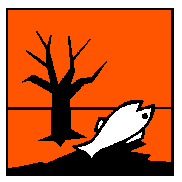International Chemical Safety Cards
| FENITROTHION | ICSC: 0622 |
| FENITROTHION O,O-Dimethyl O-4-nitro-m-tolyl phosphorothioate O,O-Dimethyl O-(3-methyl-4-nitrophenyl) phosphorothioate O,O-Dimethyl O-4-nitro-m-tolyl thiophosphate C9H12NO5PS Molecular mass: 277.25 CAS # 122-14-5 RTECS # TG0350000 ICSC # 0622 UN # 3018 EC # 015-054-00-0 |
 |
 |
| TYPES OF HAZARD/ EXPOSURE |
ACUTE HAZARDS/ SYMPTOMS |
PREVENTION | FIRST AID/ FIRE FIGHTING |
| FIRE | Combustible. Liquid
formulations containing organic solvents may be flammable. Gives off irritating or toxic
fumes (or gases) in a fire. |
NO open flames. |
Powder, water spray, foam,
carbon dioxide. |
| EXPLOSION | |
|
See Notes. |
| EXPOSURE | |
PREVENT GENERATION OF
MISTS! AVOID EXPOSURE OF ADOLESCENTS AND CHILDREN! |
IN ALL CASES CONSULT A
DOCTOR! |
| INHALATION | Cough. Headache.
Pupillary constriction, muscle cramp, excessive salivation. Nausea. Dizziness. Laboured
breathing. Convulsions. Sweating. Unconsciousness. |
Ventilation, local exhaust,
or breathing protection. |
Fresh air, rest.
Half-upright position. Artificial respiration if indicated. Refer for medical attention. |
| SKIN | MAY BE ABSORBED! Redness.
Pain (further see Inhalation). |
Protective gloves.
Protective clothing. |
Remove contaminated
clothes. Rinse and then wash skin with water and soap. Refer for medical attention. |
| EYES | Redness. Pain. |
Face shield, or eye
protection in combination with breathing protection. |
First rinse with plenty of
water for several minutes (remove contact lenses if easily possible), then take to a
doctor. |
| INGESTION | Abdominal cramps.
Confusion. Diarrhoea. Shortness of breath. Vomiting (further see Inhalation). |
Do not eat, drink, or smoke
during work. Wash hands before eating. |
Rinse mouth. Induce
vomiting (ONLY IN CONSCIOUS PERSONS!). Refer for medical attention. |
| SPILLAGE DISPOSAL | STORAGE | PACKAGING & LABELLING | ||
| Collect leaking and spilled
liquid in sealable containers as far as possible. Absorb remaining liquid in sand or
inert absorbent and remove to safe place. Do NOT wash away into sewer (extra personal
protection: chemical suit with self-contained breathing apparatus). |
Provision to contain
effluent from fire extinguishing. Separated from food and feedstuffs. Keep in a
well-ventilated room. |
Do not transport with food
and feedstuffs. Xn symbol N symbol R: 22-50/53 S: (2-)60-61 UN Hazard Class: 6.1 Severe marine pollutant. |
||
| SEE IMPORTANT INFORMATION ON BACK | ||||
|
||||